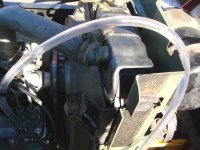I found a link that may or may not help. It is mainly about Bosch and VE, but, It has a reference to the Yanmar Pump and a picture of a cross section of one. It has a vane pump that acts as the feeder. Then there are plungers that feed the injectors. If this is true, then they are not completely gravity fed. I think I have read before that you are in the A/C business too, correct me if I am wrong. I have seen hydronic pumps with a bad mechanical seal suck air and cavitate air into the system. However, when you shut the pump down it leaks water out the seal and they are centrifugal pumps made to pump volume at low pressure. The vane pump has got to have a drive, and that drive undoubtable has a seal on it. If the seal were bad, it may be able to suck air. The problem here is you can't see the drive shaft while it is running. When you had the pump off did you see a drive shaft? If it were pushing air into the cylinder from the injector, could the air get past the piston, the vane pump, and back to the inlet line? I wonder if you could take the pump off, hook up your fuel can and line to it, and see if it leaks? I am assuming the crankcase pressure is near atmospheric pressure since it is vented.
Pressure (PSI) = feet head x 0.433 x specific gravity
Specific Gravity of Fuel Oil = 0.85 approximately
Without giving an example of the math, if the tank is 2.7 feet above the injector inlet, it will have 1 PSI (Net Positive Suction Head, NPSH). If you elevated the fuel can to 13.56 feet, that will give you 5 PSI at the fuel inlet of the pump. That should be enough to see if the shaft seal is leaking. Here is the link I mentioned before.
Robert Bosch type VE Diesel injection pump
I hope this isn't totally off the wall. If the DW comes out and sees you with a hose running from a fuel can sitting on the roof of the house she may call the men in the white coats to you.

